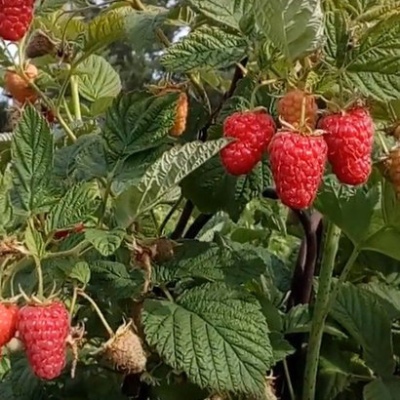
- Authors: Poland
- Berry color: bright red
- Taste: dessert
- Ripening period: average
- Berry weight, g: 6-10
- Yield: 17-20 t / ha
- Frost resistance: medium
- Appointment: fresh consumption, all types of processing
- Fruiting period: July
- Keeping quality: Yes
Among foreign breeding novelties, Sokolitsa raspberry combines all the best features of such popular varieties as Polana and Molling Promis. Among its representatives, agriculture is distinguished not only by high indicators of marketability, but also by persistent immunity to many fungal infections.
Description of the variety
In Russia, Polish raspberries appeared relatively recently. Falcon can be grown both outdoors and in greenhouses. Begins to bear fruit on 2-year-old shoots. But it can show remontant characteristics and yield a harvest on 1-year-old branches. Refers to dessert varieties. The fruits are used both fresh and processed.
Ripening terms
By the time of fruiting, it belongs to the middle type. However, the timing largely depends on the growing region. In central Russia, you can enjoy the first fruits in July. In the southern regions, ripe berries appear in early June.
Breeding raspberries in a greenhouse method, the harvest will not keep itself waiting long, the fruits can be harvested already starting from mid-May.
Yield
Very high yield. Up to 7 kg or 17-20 t / ha can be harvested from one bush. The amount of the crop can be increased up to 30 t / ha using the tunnel growing method. Harvested berries retain their shape well during long-term storage, do not flow during transportation.
Berries and their taste
Falcon belongs to large-fruited varieties. The berries have an unusual shape, slightly elongated and slightly flattened on the sides, similar to an elongated cylinder. The weight of the berry reaches 6-10 g, specimens and larger ones come across.
The color is intense, bright red. The taste is dessert, sweet, with a raspberry aroma. The pulp is dense in consistency, does not spread or crumble.

Growing features
Agriculture is quite demanding to care for. The variety perfectly tolerates dry summers. Excess moisture in the soil is extremely detrimental to the plant.
For successful cultivation, it is advisable to tie up raspberries. So bushes 170-200 cm high will not bend under the weight of ripe berries. In addition, the trellis planting method allows air to pass freely between the stems, preventing fungal infections from multiplying on the culture.
Spreading bushes, strong and dense. Shoots with arcuate curved tops, medium thickness, tough. Leaves of medium size, rich green color, with narrow teeth.
Falcon must be prepared for winter. With the onset of the first cold weather, the soil around the seedlings is mulched, the shoots are bent down and covered with agrofibre. It is possible to remove protection from the culture when the threat of frost has passed and warm weather is established.
Site selection and soil preparation
The plot is chosen sunny, protected from strong winds. Places located on a small hill will be preferable. The plant categorically does not tolerate stagnant moisture.
Raspberries grow well on fertile soils (loamy or sandy loam).Poor soil must be enriched with mineral and organic fertilizers.


Pruning
Pruning is carried out 2 times a year. In the fall, necessarily remove the 2-year-old stems on which the stalks were. In the spring, the site is sanitized from broken and frozen branches.
It is necessary to thin out young growth. Its quantity should be constantly monitored. Since excessive thickening has a detrimental effect on both the amount of the crop and the health of the plants. Excessive shading contributes to the development of fungal diseases.

Watering and feeding
The variety is not too picky about the amount of moisture, which is very important for the southern regions. During the season, only a few waterings are required during flowering and fruit setting.
You need to feed the plant 3 times per season. In the spring, nitrogen-containing fertilizers are applied for better development of the green part. It can be both mineral preparations and organic matter (ash). When fruits begin to form, complex fertilizers will be required.
In the fall, after harvesting, phosphorus is needed, which will make it possible to prepare raspberries for winter so that they can please with a rich harvest next season.




Unfortunately, raspberries, like other plants, do not bypass various diseases and pests. Only armed with the knowledge and the necessary means for this, you can cope with such troubles. To help the plant, it is very important to be able to recognize the disease in time and begin timely treatment.
Reproduction
Propagating Sokolitsa will not be difficult. Every year she releases a large number of young growth, which can be used to start a new raspberry tree.
Saplings are planted either in the spring (when a constant positive temperature is established) or in the fall (with the onset of leaf fall). For the Urals and Siberia, spring breeding will be preferable. During this time, the culture will have time to take root and gain strength before the upcoming harsh winter.
Before planting, prepare holes or a trench with a depth of 10-15 cm. Preliminarily adding food in the form of humus, ash, phosphorus-potassium fertilizer. The distance between the bushes is 60 cm, between the rows - 1 m.The seedlings are cut to 35 cm.
When using purchased seedlings with an open root system, it is recommended to place them in a growth stimulant solution for several hours before planting. It is advisable to purchase plants with closed roots. The chances that they will take root are higher.
After planting, the soil around them is rammed, watered and mulched. The added dressings are enough for several years. This will be followed by regular fertilization.








































































